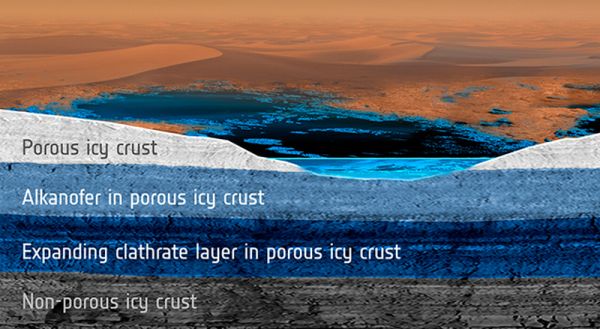Information gathered by NASA in collaboration with European Space Agency Cassini mission has surfaced presence of numerous lakes across the northern polar area of Titan. Instead of consisting of water, these seas are composed of hydrocarbons, the organic compounds that are also present on Earth. As per the previous studies, the rainfall from the surface clouds brings about major amount of liquid on Saturn’s moon. However, the cycle of liquid moving through the moon’s crust and the atmosphere is still under consideration.
Olivier Mousis one of the Cassini researchers observed how the rainfall saturated with methane would interact with materials at sub-zero temperature in the subsurface reservoirs. He discovered the presence of clathrates that alters the chemical composition of rainfall runoff, which charges these hydrocarbon “aquifers.” Consequent upon which, reservoirs of hydrocarbons like those of propane and ethane are formed that might also enter into the other water-bodies.
There are chances of linking between underground reservoirs with lakes on the surface of the moon but the process of interaction was out of vision. Now, with the recent observation, the idea is somewhat clear relatively, said Mousis.
Icy aquifers
Researchers from Cornell University and NASA’s Jet Propulsion Laboratory modeled how underground reservoirs consisting of hydrocarbons would circulate across the moon’s spongy, icy crust. They noticed that at the bottom of the initially created methane composite reservoir, a second pool would gradually form. This derived reservoir would be mainly composed of clathrates.
A clathrate is a lattice-structured substance that traps other materials and in this case, it would be methane & ethane. Methane contained clathrates are present on Earth. Surface pressure and temperature on Titan favor clathrates to morph when liquid hydrocarbons meet water ice, which is also a main element of Titan. These layers of clathrates may continue to exist up to several miles at subsurface level.
Fractionation
These clathrates not only fence in molecules but they also spilt compounds into liquid and solid phases and the process is known as fractionation. Upon interacting with methane at the underground reservoirs, clathrates might fractionate it from the previously created subsurface hydrocarbon lake, thus gradually altering its composition and morphing the original methane aquifer into propane or ethane aquifer.
Chemical transformation occurring at the subsurface level would also affect the surface composition of the moon. The water bodies at the subsurface level of Titan’s surface reflect the same composition while those fed by rainfall contain a considerable portion of methane. This also implies that by studying the surface level composition, researchers could get insights about the internal strata of the moon.
Source: NASA Jet Propulsion Laboratory




